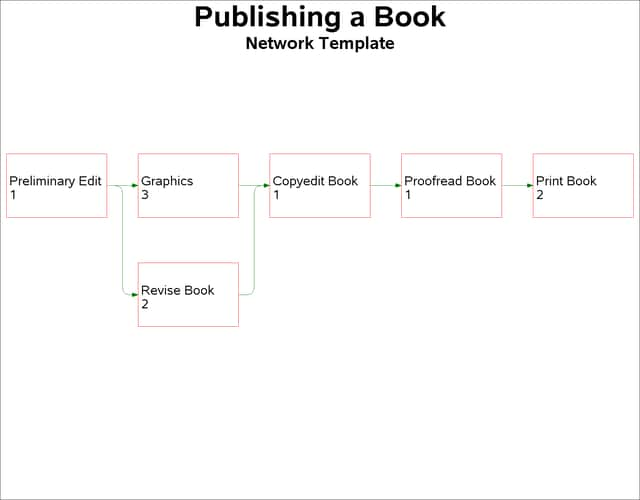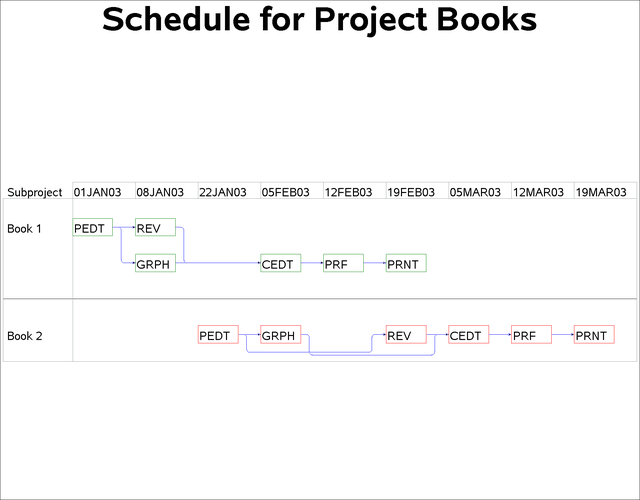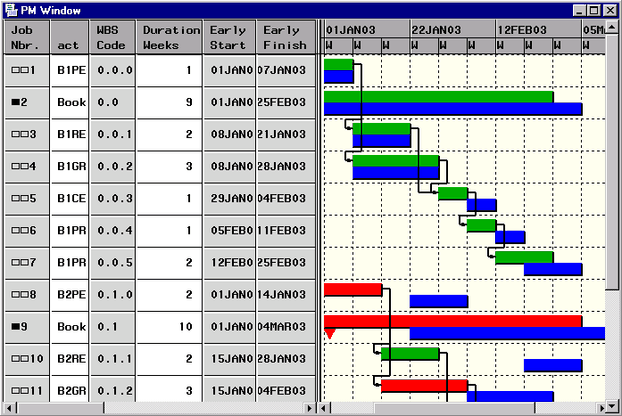Often a project is divided into several subprojects, each of which is then broken into activities with precedence constraints. For reporting or accounting purposes, it may be essential to group activities or to aggregate the information pertaining to activities in a given group. Sometimes, totally different projects use a common pool of resources and you may want to schedule all the projects using the common pool; you may want to vary the priority with which the resources are allotted to the activities on the basis of the projects to which they belong. Often, you have several projects that are essentially the same, with only a few minor differences; these projects may also share a common pool of resources. In such cases, you may want to have a project template listing all the activities and their precedence relationships; for each specific project you can copy the template, make any modifications that are necessary for the given scenario, and determine the project schedule accordingly.
This example illustrates some of these possibilities for a multiproject scenario. The project is first scheduled using PROC CPM, and then the PM procedure is used with the same input data set to illustrate the project displayed in the PM Window.
Consider a publishing company that accepts manuscripts from different authors for publication. The publication of each book can be treated as a project. Thus, at a given point in time, several projects, almost identical in nature, may be in progress. Some of the resources that may be needed are a technical editor, a copyeditor, and a graphic artist. All the books that are currently being worked on share a common pool of these resources. This example uses a simplified version of such a scenario to illustrate some of the ways in which you can handle multiple projects competing for the same pool of resources.
The network in Output 3.6.1 represents some of the tasks required to publish one book and the precedence constraints among these tasks; the durations
in the diagram are in weeks. Suppose that the generic project data are in the data set book, which is displayed in Output 3.6.2. This data set is used as a template for creating the Activity data set for any book publishing project.
Suppose that the company is working on two books simultaneously. The editor and artist must now allocate their time between
the two books. The following program uses the template data set book to create Activity data sets book1 and book2 corresponding to the publication of each book. Any modifications to the generic project data can be made in the DATA step
or by using PROC PM. In this example, the duration for the first activity, 'Preliminary Edit,' is changed to two weeks for
the second book. The two Activity data sets book1 and book2 are also displayed in Output 3.6.2.
data book1; length act $6. succ $6.; set book; subproj = "Book 1"; act = "B1"||task; if succ ^= " " then succ = "B1"||succ; run; data book2; length act $6. succ $6.; set book; subproj = "Book 2"; act = "B2"||task; if act = "B2PEDT" then dur = 2; if succ ^= " " then succ = "B2"||succ; run;
title 'Publishing Book 1'; proc print data=book1; var subproj task act succ id dur editor artist; run; title 'Publishing Book 2'; proc print data=book2; var subproj task act succ id dur editor artist; run;
Output 3.6.2: Template and Activity Data Sets for Book Publishing Example
| Publishing Book 1 |
| Obs | subproj | task | act | succ | id | dur | editor | artist |
|---|---|---|---|---|---|---|---|---|
| 1 | Book 1 | PEDT | B1PEDT | B1REV | Preliminary Edit | 1 | 1 | . |
| 2 | Book 1 | PEDT | B1PEDT | B1GRPH | Preliminary Edit | 1 | 1 | . |
| 3 | Book 1 | REV | B1REV | B1CEDT | Revise Book | 2 | 1 | . |
| 4 | Book 1 | GRPH | B1GRPH | B1CEDT | Graphics | 3 | . | 1 |
| 5 | Book 1 | CEDT | B1CEDT | B1PRF | Copyedit Book | 1 | 1 | . |
| 6 | Book 1 | PRF | B1PRF | B1PRNT | Proofread Book | 1 | 1 | . |
| 7 | Book 1 | PRNT | B1PRNT | Print Book | 2 | . | . |
| Publishing Book 2 |
| Obs | subproj | task | act | succ | id | dur | editor | artist |
|---|---|---|---|---|---|---|---|---|
| 1 | Book 2 | PEDT | B2PEDT | B2REV | Preliminary Edit | 2 | 1 | . |
| 2 | Book 2 | PEDT | B2PEDT | B2GRPH | Preliminary Edit | 2 | 1 | . |
| 3 | Book 2 | REV | B2REV | B2CEDT | Revise Book | 2 | 1 | . |
| 4 | Book 2 | GRPH | B2GRPH | B2CEDT | Graphics | 3 | . | 1 |
| 5 | Book 2 | CEDT | B2CEDT | B2PRF | Copyedit Book | 1 | 1 | . |
| 6 | Book 2 | PRF | B2PRF | B2PRNT | Proofread Book | 1 | 1 | . |
| 7 | Book 2 | PRNT | B2PRNT | Print Book | 2 | . | . |
As a next step, the data sets for the two subprojects are combined to form an Activity data set for the entire project. A
variable priority is assigned the value '1' for activities pertaining to the first book and the value '2' for those pertaining to the second
one. In other words, Book 1 has priority over Book 2. The Resource data set specifies the availability for each of the resources
to be 1. The input data sets, books and resource, are displayed in Output 3.6.3.
data books; set book1 book2; if subproj = "Book 1" then priority = 1; else priority = 2; run; data resource; input avdate & date7. editor artist; format avdate date7.; datalines; 1jan03 1 1 ;
title 'Publishing Books 1 and 2'; proc print data=books; var subproj priority task act succ id dur editor artist; run; title 'Resources Available'; proc print data=resource; run;
Output 3.6.3: Input Data Sets for Book Publishing Example
| Publishing Books 1 and 2 |
| Obs | subproj | priority | task | act | succ | id | dur | editor | artist |
|---|---|---|---|---|---|---|---|---|---|
| 1 | Book 1 | 1 | PEDT | B1PEDT | B1REV | Preliminary Edit | 1 | 1 | . |
| 2 | Book 1 | 1 | PEDT | B1PEDT | B1GRPH | Preliminary Edit | 1 | 1 | . |
| 3 | Book 1 | 1 | REV | B1REV | B1CEDT | Revise Book | 2 | 1 | . |
| 4 | Book 1 | 1 | GRPH | B1GRPH | B1CEDT | Graphics | 3 | . | 1 |
| 5 | Book 1 | 1 | CEDT | B1CEDT | B1PRF | Copyedit Book | 1 | 1 | . |
| 6 | Book 1 | 1 | PRF | B1PRF | B1PRNT | Proofread Book | 1 | 1 | . |
| 7 | Book 1 | 1 | PRNT | B1PRNT | Print Book | 2 | . | . | |
| 8 | Book 2 | 2 | PEDT | B2PEDT | B2REV | Preliminary Edit | 2 | 1 | . |
| 9 | Book 2 | 2 | PEDT | B2PEDT | B2GRPH | Preliminary Edit | 2 | 1 | . |
| 10 | Book 2 | 2 | REV | B2REV | B2CEDT | Revise Book | 2 | 1 | . |
| 11 | Book 2 | 2 | GRPH | B2GRPH | B2CEDT | Graphics | 3 | . | 1 |
| 12 | Book 2 | 2 | CEDT | B2CEDT | B2PRF | Copyedit Book | 1 | 1 | . |
| 13 | Book 2 | 2 | PRF | B2PRF | B2PRNT | Proofread Book | 1 | 1 | . |
| 14 | Book 2 | 2 | PRNT | B2PRNT | Print Book | 2 | . | . |
| Resources Available |
| Obs | avdate | editor | artist |
|---|---|---|---|
| 1 | 01JAN03 | 1 | 1 |
PROC CPM is then invoked to schedule the project to start on January 1, 2003. The PROJECT statement is used to indicate the
subproject to which each activity belongs. The data set bookschd (displayed in Output 3.6.4) contains the schedule for the entire project. The ADDACT option on the PROC CPM statement adds observations for each of
the subprojects, 'Book 1' and 'Book 2,' as well as one observation for the entire project. These observations are added at
the end of the list of the observations corresponding to the observations in the input data set. The Usage data set booksout is also displayed in Output 3.6.4.
proc cpm data=books resin=resource
out=bookschd resout=booksout
date='1jan03'd interval=week
addact;
act act;
dur dur;
succ succ;
resource editor artist / per=avdate avp rcp
rule=actprty actprty=priority
delayanalysis;
id id task;
project subproj;
run;
Compare the E_START and S_START schedules (in the data set bookschd) and note that on January 1, the activity 'B1PEDT' for Book1 is scheduled to start while the preliminary editing of book
2 (activity B2PEDT) has been postponed, due to subproject 'Book 1' having priority over subproject 'Book 2.' On January 22,
there is no activity belonging to subproject 'Book 1' that demands an editor; thus, the activity 'B2PEDT' is scheduled to
start on that day. As a result, the editor is working on an activity in the second project for two weeks starting from January
22, 2003; when 'B1CEDT' is ready to start, the editor is not available, causing a delay in this activity. Thus, even though
the first book has priority over the second book, the scheduling algorithm does not keep a resource waiting for activities
in the first project. However, if you enable activity splitting, you can reclaim the resource for the first book by allowing
activities in the second project to be split, if necessary. For details regarding the scheduling algorithm allowing splitting
of activities, see Chapter 4: The CPM Procedure.
Note: The entire project finishes on April 1, 2003; resource constraints have delayed project completion by four weeks. The variable
R_DELAY in the Schedule data set bookschd indicates the amount of delay in weeks caused by resource constraints. The value of R_DELAY does not include any delay in the activity that is caused by a resource delay in one of its predecessors. See Example 4.15 in Chapter 4: The CPM Procedure, for more details about the R_DELAY variable.
Output 3.6.4: Data Sets BOOKSCHD and BOOKSOUT
| Schedule for Project BOOKS |
| Obs | subproj | PROJ_DUR | PROJ_LEV | act | succ | dur | id | task | editor | artist | S_START | S_FINISH | E_START | E_FINISH | L_START | L_FINISH | R_DELAY | DELAY_R | SUPPL_R |
|---|---|---|---|---|---|---|---|---|---|---|---|---|---|---|---|---|---|---|---|
| 1 | Book 1 | . | 2 | B1PEDT | B1REV | 1 | Preliminary Edit | PEDT | 1 | . | 01JAN03 | 07JAN03 | 01JAN03 | 07JAN03 | 08JAN03 | 14JAN03 | 0 | ||
| 2 | Book 1 | . | 2 | B1PEDT | B1GRPH | 1 | Preliminary Edit | PEDT | 1 | . | 01JAN03 | 07JAN03 | 01JAN03 | 07JAN03 | 08JAN03 | 14JAN03 | 0 | ||
| 3 | Book 1 | . | 2 | B1REV | B1CEDT | 2 | Revise Book | REV | 1 | . | 08JAN03 | 21JAN03 | 08JAN03 | 21JAN03 | 22JAN03 | 04FEB03 | 0 | ||
| 4 | Book 1 | . | 2 | B1GRPH | B1CEDT | 3 | Graphics | GRPH | . | 1 | 08JAN03 | 28JAN03 | 08JAN03 | 28JAN03 | 15JAN03 | 04FEB03 | 0 | ||
| 5 | Book 1 | . | 2 | B1CEDT | B1PRF | 1 | Copyedit Book | CEDT | 1 | . | 05FEB03 | 11FEB03 | 29JAN03 | 04FEB03 | 05FEB03 | 11FEB03 | 1 | editor | |
| 6 | Book 1 | . | 2 | B1PRF | B1PRNT | 1 | Proofread Book | PRF | 1 | . | 12FEB03 | 18FEB03 | 05FEB03 | 11FEB03 | 12FEB03 | 18FEB03 | 0 | ||
| 7 | Book 1 | . | 2 | B1PRNT | 2 | Print Book | PRNT | . | . | 19FEB03 | 04MAR03 | 12FEB03 | 25FEB03 | 19FEB03 | 04MAR03 | 0 | |||
| 8 | Book 2 | . | 2 | B2PEDT | B2REV | 2 | Preliminary Edit | PEDT | 1 | . | 22JAN03 | 04FEB03 | 01JAN03 | 14JAN03 | 01JAN03 | 14JAN03 | 3 | editor | |
| 9 | Book 2 | . | 2 | B2PEDT | B2GRPH | 2 | Preliminary Edit | PEDT | 1 | . | 22JAN03 | 04FEB03 | 01JAN03 | 14JAN03 | 01JAN03 | 14JAN03 | 3 | editor | |
| 10 | Book 2 | . | 2 | B2REV | B2CEDT | 2 | Revise Book | REV | 1 | . | 19FEB03 | 04MAR03 | 15JAN03 | 28JAN03 | 22JAN03 | 04FEB03 | 2 | editor | |
| 11 | Book 2 | . | 2 | B2GRPH | B2CEDT | 3 | Graphics | GRPH | . | 1 | 05FEB03 | 25FEB03 | 15JAN03 | 04FEB03 | 15JAN03 | 04FEB03 | 0 | ||
| 12 | Book 2 | . | 2 | B2CEDT | B2PRF | 1 | Copyedit Book | CEDT | 1 | . | 05MAR03 | 11MAR03 | 05FEB03 | 11FEB03 | 05FEB03 | 11FEB03 | 0 | ||
| 13 | Book 2 | . | 2 | B2PRF | B2PRNT | 1 | Proofread Book | PRF | 1 | . | 12MAR03 | 18MAR03 | 12FEB03 | 18FEB03 | 12FEB03 | 18FEB03 | 0 | ||
| 14 | Book 2 | . | 2 | B2PRNT | 2 | Print Book | PRNT | . | . | 19MAR03 | 01APR03 | 19FEB03 | 04MAR03 | 19FEB03 | 04MAR03 | 0 | |||
| 15 | 9 | 1 | Book 1 | . | . | . | 01JAN03 | 04MAR03 | 01JAN03 | 25FEB03 | 08JAN03 | 04MAR03 | 0 | ||||||
| 16 | 10 | 1 | Book 2 | . | . | . | 22JAN03 | 01APR03 | 01JAN03 | 04MAR03 | 01JAN03 | 04MAR03 | 3 | ||||||
| 17 | 13 | 0 | . | . | . | 01JAN03 | 01APR03 | 01JAN03 | 04MAR03 | 01JAN03 | 04MAR03 | 0 |
| Resource Usage for Project BOOKS |
| Obs | _TIME_ | Reditor | Aeditor | Rartist | Aartist |
|---|---|---|---|---|---|
| 1 | 01JAN03 | 1 | 0 | 0 | 1 |
| 2 | 08JAN03 | 1 | 0 | 1 | 0 |
| 3 | 15JAN03 | 1 | 0 | 1 | 0 |
| 4 | 22JAN03 | 1 | 0 | 1 | 0 |
| 5 | 29JAN03 | 1 | 0 | 0 | 1 |
| 6 | 05FEB03 | 1 | 0 | 1 | 0 |
| 7 | 12FEB03 | 1 | 0 | 1 | 0 |
| 8 | 19FEB03 | 1 | 0 | 1 | 0 |
| 9 | 26FEB03 | 1 | 0 | 0 | 1 |
| 10 | 05MAR03 | 1 | 0 | 0 | 1 |
| 11 | 12MAR03 | 1 | 0 | 0 | 1 |
| 12 | 19MAR03 | 0 | 1 | 0 | 1 |
| 13 | 26MAR03 | 0 | 1 | 0 | 1 |
| 14 | 02APR03 | 0 | 1 | 0 | 1 |
The output data sets bookschd and booksout can be used to produce graphical reports of the schedule and the resource usage. In particular, the Schedule data set can
be used to produce a zoned, time-scaled network diagram as shown in Output 3.6.5. The program used to produce the network diagram is shown in the following code. In this example, only the leaf tasks (those
without any subtasks) are used to draw the network diagram. Further, the activities are aligned according to the resource-constrained
start times and grouped according to the subproject.
goptions hpos=98 vpos=60;
pattern1 v=e c=green;
pattern2 v=e c=red;
title c=black h=4 'Schedule for Project Books';
proc netdraw data=bookschd(where=(proj_dur=.)) graphics;
actnet / act=act succ=succ
id=(task) nodefid nolabel
xbetween=8 htext=3 pcompress
zone=subproj zonepat zonespace
align=s_start separatearcs;
label subproj = 'Subproject';
run;
The same project can also be scheduled using the PM procedure, as shown in the following statements. The resulting PM Window is shown in Output 3.6.6. The advantage with using PROC PM is that you can use the PM Window to edit the activity information, such as the durations, resource requirements, and so forth.
proc pm data=books resin=resource
out=pmsched resout=pmrout
date='1jan03'd interval=week;
act act;
dur dur;
succ succ;
resource editor artist / per=avdate
avp rcp
rule=actprty
actprty=priority
delayanalysis;
id id task;
project subproj;
run;


